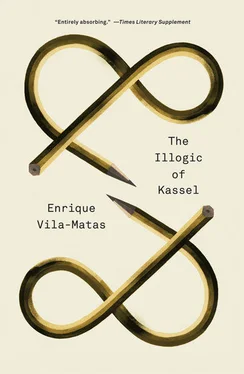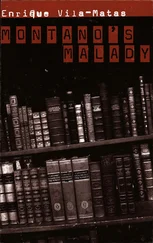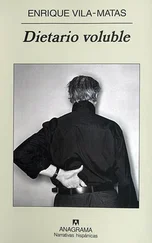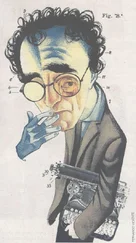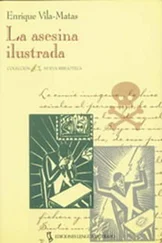I remained impassive, thinking of those linguistic short circuits that are inevitably part of the most mundane conversations. “Nice day today, ma’am.” “Don’t even go there, sir.” “Did you see that amazing light?” And the lady doesn’t answer. Brusque interruptions, the breakdown of language in the most pointless exchanges. Of course, people contribute to the short circuit sometimes without even wanting to.
Toward evening we arrived at the Hauptbahnhof to see Artaud’s Cave , a film installation made for Documenta by the Venezuelan artist Javier Téllez. It was showing in a strange space inside the old station.
On the way over, Ada Ara, Boston, and I talked about my ridiculous mix-up with Carolyn. The only thing that might have been worse, said Boston, is if you’d told her the world is kept spinning by two tsetse flies.
In that space in the Hauptbahnhof — designed as a cinema but looking like a grotto — Téllez looped his single-channel film. This was what Boston and Ada told me, thinking that since Artaud was involved the work would surely interest me. The installation showed a performance of The Conquest of Mexico , an Artaud text that I recalled sought to bludgeon the viewer, to create the harsh effect of an ax-blow on the frozen sea lying within us all. It was all very much in line with theories forming the foundation of the Theater of Cruelty, established by Artaud himself in his bid to make an aggressive impression on the spectator: “For that reason, actions, nearly always violent, come before words, thus freeing the subconscious to fight against reason and logic.”
The video by Téllez was extraordinarily interesting and subconscious-freeing: it was acted out by mentally ill patients from the Bernardino Álvarez hospital in Mexico City. The video took place in two parallel time frames, alternating daily life in the psychiatric institution with the historical events of the conquest of Mexico as told by Artaud, which made the patients of the Bernardino Álvarez duplicate themselves ingeniously: playing themselves as patients and at the same time identifying with Moctezuma and other historical characters.
I didn’t say anything, and it seemed as if I wasn’t interested in the cave, or the video, or the conquest of Mexico. But that wasn’t the case; it was that I’d just seen the young blonde German approaching, the woman in strict mourning I’d seen before at Untilled , enlightening people about the death of Europe. It was unmistakably her, still in the same dark clothing and once more shouting at people as she came toward us. Arriving where we were, she handed us a sort of pamphlet she had written and was distributing to inform us that Antonin Artaud was one of the first to condemn the Enlightenment for destroying the West. In fact, it was nothing very different from what she’d said previously from up on a pile of rubble.
I went so far as to think the vociferous young woman had reason on her side. Was she reasonably mad? Nothing was further from the spirit than rationality, and for that very reason, rationality was the peak of madness. The young blonde woman in unrelenting mourning was, moreover, quite right to remind us that Artaud was a pioneer when it came to identifying Europeans as the living dead.
Artaud screamed, too. Or was I thinking of Humboldt, that Saul Bellow character who used to reminisce about the day Artaud invited the most brilliant Parisian intellectuals to a conference and when he had them all gathered there, he read nothing, but went up on stage, simply yelping at them like a wild animal? It seemed Artaud went on letting out deafening shrieks, while the Parisian intellectuals remained sitting there, petrified. Yet, for them, it was an exquisite act. And why? Humboldt said that in some way Artaud had understood that the only art that interested intellectuals was one that celebrated the primacy of ideas. Artists had to interest intellectuals, the new class. That’s why the position of culture and of the history of culture had become the main theme of art. And that’s why a refined French audience respectfully listened to Artaud while he screamed. For them the sole objective of art was to suggest or inspire ideas. .
If I thought hard about it, hadn’t I acted that way too, since arriving in Kassel? From the word go, I’d been pleased by the prospect that theories running through Documenta might inspire me with ideas for my own work. In fact, I suspected that some of those ideas had already permeated my personality and, like a powerful drug, had left me in such a pleasant condition that my habitual despondency at that hour didn’t even dare to put in an appearance. That was one of the things that was happening: despite it being close to dusk, anguish didn’t arrive punctually for its usual appointment with me. It was without a doubt totally unusual; maybe anguish was just running a little late.
What was happening was that anguish appeared to have vanished and been secretly replaced by a great admiration for the complexity of what I’d seen in Kassel. That complexity had become part of my new personality. It was as if what was happening to me there had a direct link with those words of Mallarmé to Manet: “Paint, not the thing, but the effect it produces.” The effect on me of some of the work at Documenta was altering my way of being.
That stunning complexity, that Alcarria of art, was truly a marvel, and I was seeing it with the eyes of Raymond Roussel.
So I was sorry to have to wreck the gloomy predictions so many friends were making about the end of art, which they unfortunately confused with the end of the world, an entirely different matter. It seemed to me that art was still holding up perfectly well, and it was only the world, with its two dizzying tsetse flies, that had crumbled.
It was there in Artaud’s cave that I remembered my old conviction — still holding true from what I could tell — that anyone who dedicated himself to literature had not renounced the world; the world had simply evicted him, or never admitted him as a tenant. Nothing serious, then; in the end, a poet was someone for whom the world didn’t even exist, because, for him, there was only the radiance of the eternal outside.
I was thinking all this, and it was as if the cries of the radical young German woman fundamentally appealed to me. I had to really force myself to move away from that unhinged ranter. I was helped by my tremendous accumulated fatigue as much as by the invisible breeze: for a moment they both seemed to have joined forces to try to hold my interest in everything except the shouting. And so I soon managed to dodge the young madwoman in mourning — with a slight twinge, because underneath it all I liked her madness — and I was able to concentrate on the video being shown in that artificial cave.
I noticed I continued to be interested in everything. Not long before, I’d even been interested in the soothing, ruddy sunset, which, going into the cave, we’d left behind and which plenty of people had been paying too much attention to, as though it were part of Documenta. My reaction to the anodyne sunset had been very emotional, as it reminded me of my father who, before going off to his daily labor year after year (which began at sunset), always sang “Pace non trovo,” and his voice in the shower rang out with a succession of squeaks caused by excessive sorrow (perhaps at not having dedicated himself to opera). It resounded with excessive volume and excessive despair.
I was also emotional inside Artaud’s cave, because on top of everything, each time I looked off into the distance, I thought I saw the sea. It was a receding sea, which revealed a more distant sea, and in the end only allowed me to surmise a series of seas without coastlines. This visual effect seemed to tell me I should dare to go farther, unafraid, far from any handful of dust or misunderstanding of this world, that I should dare to go toward other conjectures, also without coastlines.
Читать дальше
